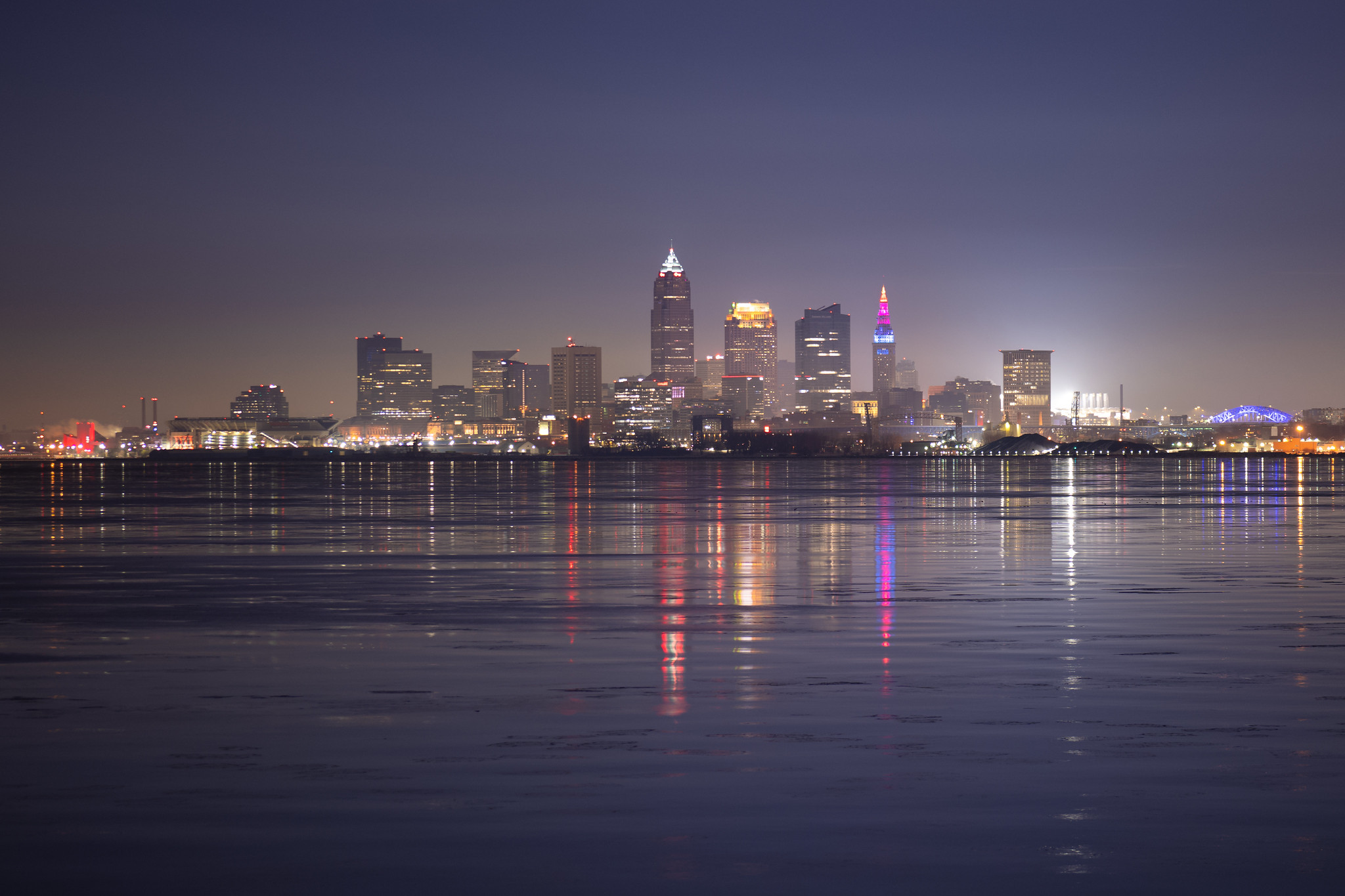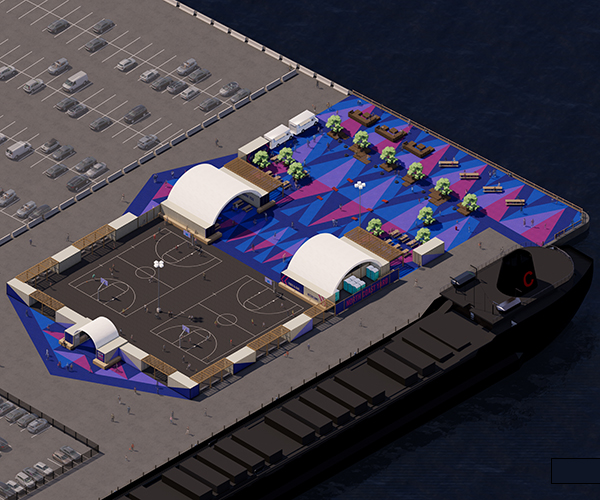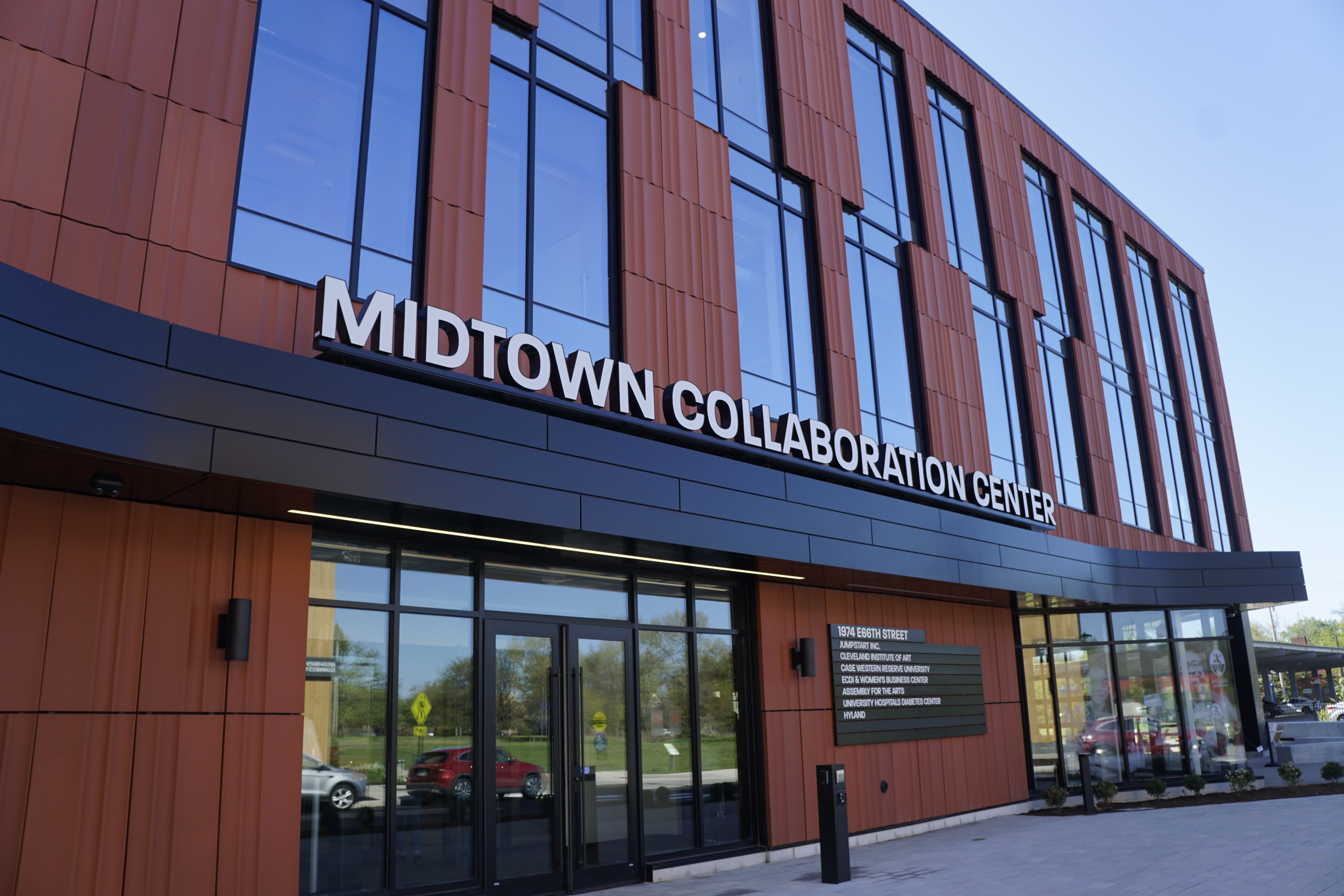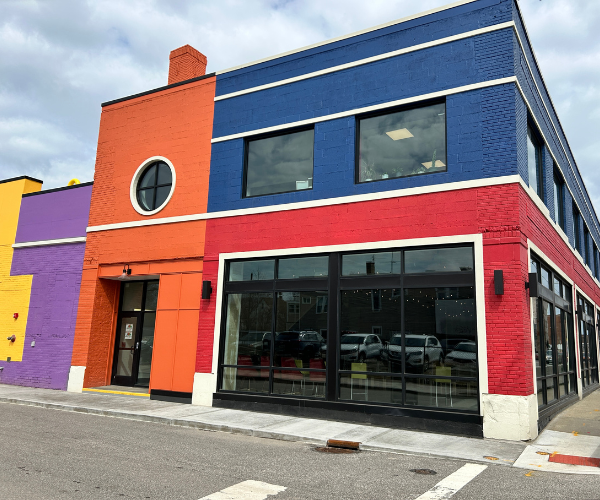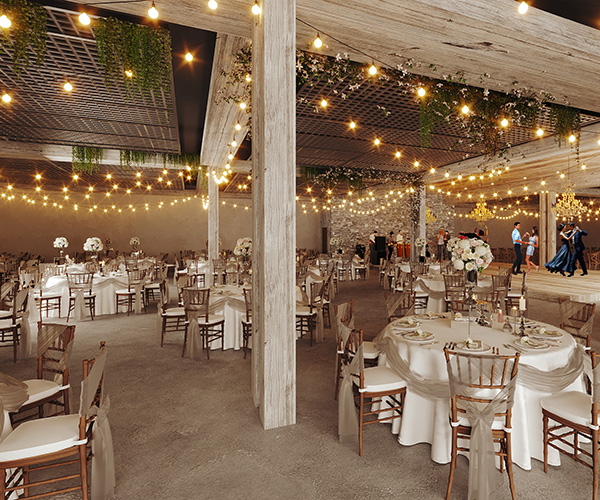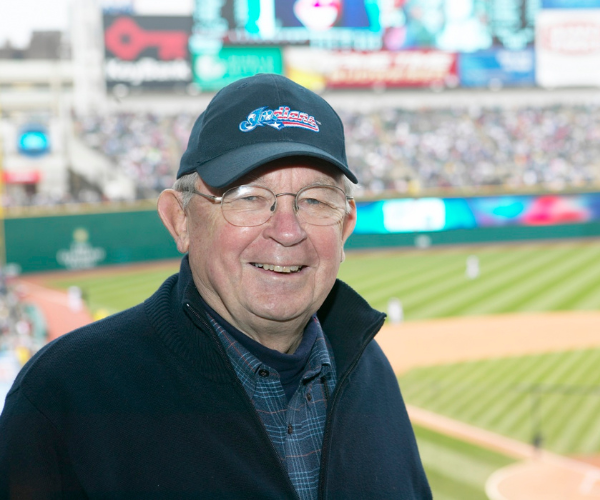Journeys On The Cuyahoga
by Sheehan Hannan | Jun. 3, 2019 | 12:00 PM

PHOTOGRAPHED BY CODY YORK
1. THE BURNING RIVER, PART I
Deep in the bowels of the industrial Flats, surrounded by steel plants and rolling mills, there’s a beach.
Scrambling down a scrubby hill, I find several neon green and blue kayaks resting on the sand beside a bend in the Cuyahoga River. Fifty years ago this month, that river was so polluted it caught on fire. Yet here are three men, lounging in the kayaks on its banks, drinking Great Lakes Brewing Co. Edmund Fitzgerald. They offer me a beer.
I say no. I’m on the clock. But really, I’m just nervous. Today we are heading out on a 6 1/2-mile journey that will take us through the industrial Cuyahoga. And I’m worried I’ll be too much of a wimp to finish the trip.
I have lived in Cleveland for almost a decade and in that time, I have passed over the river on bridges, ogled the old Coast Guard station at its mouth, eaten meals on patios a few feet from its lapping waters and walked along trails that trace its length. I even once rode along the industrial channel in a boat.
But while doing all those things, I realized, I still knew curiously little about the Cuyahoga. I knew of the fire and the Flats, and had a vague knowledge that somewhere south of here it passes through Cuyahoga Falls and the Cuyahoga Valley National Park. But I was surprised, as I began research for this story, to discover it is 84 miles long.
READ MORE: The Mighty Cuyahoga River
My instinct, in realizing such a sinful gap in my knowledge, is to over-educate myself. So, with the surprisingly enthusiastic sign-off of my editor, in March, I began to plan a journey along every passable one of the Cuyahoga’s 84 miles. I checked out some books from the library and pulled newspaper clippings, and found that two groups of reporters had tried this journey before, in 1948 and 1971. So it was possible. I wanted to do what they did — see the state of the river firsthand, get the grand sweep. Almost exactly 50 years after the fire, I would try to survey the entire river.
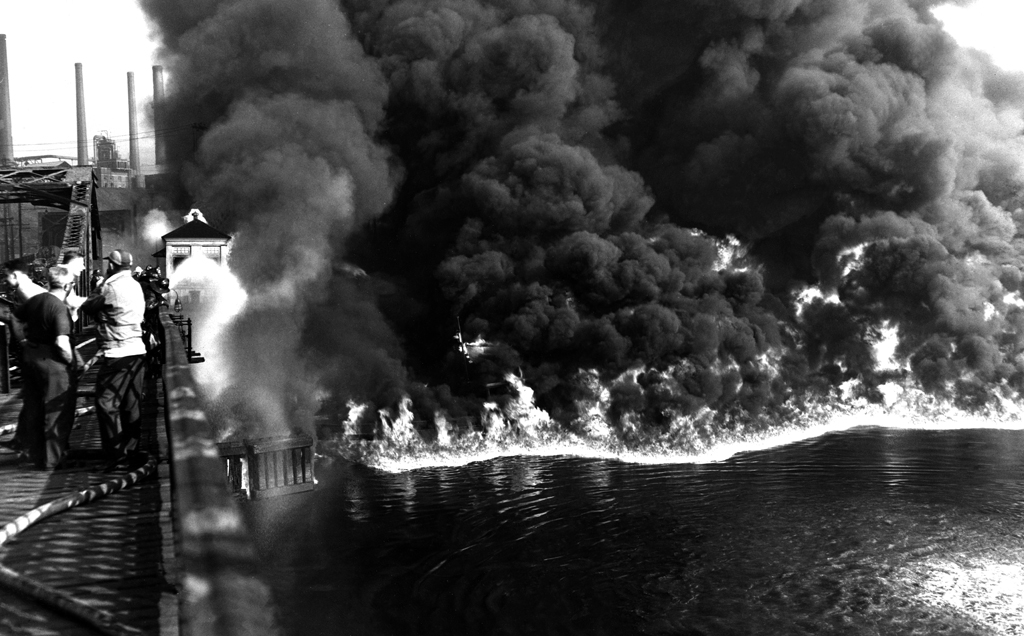
Two weeks of phone calls and meetings disabused me of that notion. The April weather would be cold and rainy, making water levels dangerously high and putting me at hypothermia risk. The logistics of sending me and a safety pal down the whole stretch would be difficult and expensive to arrange.
Planning the route was a pain as well, since there is no definitive, up-to-date, recreation-friendly map of the whole river. A group, the Cuyahoga River Water Trail, is trying to make one, but their map is still only a draft. Using that draft as a starting point, I was forced to make my own by penciling information I gathered online, and from a handful of kayakers, onto several huge printouts.
In the end, I settled for four trips along a selection of the river’s major stretches — the headwaters, the area around Cuyahoga Falls, the Cuyahoga Valley National Park and the industrial channel in downtown Cleveland. It totaled at about 20 miles.
Even with a reduced route, I still fretted over my physical limitations. My body is built not by gyms and protein powders, but magazines, comics, novels, video games and hamburgers. I was told another reporter who attempted to kayak just the six miles of the industrial channel in downtown Cleveland a few years ago had to be towed for the final two miles. The kayak rental company owner who shared that tidbit was too nice to say it, but I worried the chance of me doing even 20 miles was about as fat as my waistline.
And so, on a mercifully warm April afternoon, I find myself apprehensively turning down a beer on a beach across the river from a site where the notorious polluter Harshaw Chemical Co. once refined uranium.
READ MORE: Two Friends Skate From Cincinnati to Cleveland for Charity
We finally push the kayaks, provided by Brad McBride of Burning River Adventures, into the water and paddle up the Cuyahoga River channel. As we pass long, gray ArcelorMittal buildings on left and right, and a man sleeping on a folding chair beneath a bridge, a horrible stink washes over us. It gets stronger by the moment as we round a bend toward the ArcelorMittal blast furnace. “I think it happened right around here,” yells Jim Ridge, founder of the river advocacy nonprofit Share the River, who has joined us on the water.
The railroad trestles above the water, which the river flames lit on fire in 1969, are held up by concrete now. But the old wooden supports still stick out of the water. They’re still crispy, blackened like bonfire logs. But there are no pools or slicks of pollution in sight. I dip my hand into the water. It comes out clean, and smells fresh.
Experts had recommended I not drink it. Bacteria from Akron and the Northeast Ohio Regional Sewer District’s combined sewers can still stream into the river after heavy rains. I might guzzle what they call “fecal matter.” But I guess it’s been at least a week since a downpour. What the hell.
Fifty years after the fire, I put a few drops on my tongue.
It tastes like nothing. Like water should.

2. A CUYAHOGA HISTORY
No event in Cleveland’s recent history has been more consequential than the fire of June 22, 1969. It was an allegory for a failing city and a system that let pollution run willy-nilly into public waters. It was a national call to action. But to Tim Donovan, it was just a day off.
Donovan was 18 then, and had just graduated from high school. For a summer job, he worked at the Jones & Laughlin steel mill along the river. He filled in with a number of work crews. Once, he donned a heat-resistant silver spaceman suit and tended the sand canals through which molten ore poured. For another assignment, he worked as a hatch tender down by the Cuyahoga.
“It would bubble like a cauldron of oil,” Donovan tells me. He saw large rats with lesions bursting from their bodies skittering along the bulkheads that lined the banks, and black skims of ooze floating in the water. “We had, as a general rule: “Don’t fall into the river,’ ” Donovan says. “If you fall in the river, you’re going to a hospital immediately.”
The typical response among Clevelanders of the era was to shrug. Leading up to the 1969 fire, there was utilitarian attitude toward the Cuyahoga. It was a natural resource to be exploited and managed for commercial purposes, like timber or coal or oil.
READ MORE: What the Cuyahoga River Means to Cleveland
The mentality can be traced to the city’s founding. Moses Cleveland, who stepped off his bateau after a Lake Erie voyage and plopped his boots on the Cuyahoga’s banks more than 200 years ago, would have recognized the moneymaking potential of the river. It was inhospitable then — two men in Cleveland’s party, searching for food, found only a snake, which they boiled and ate — but its location between the mercantile East and the raw goods of the pioneer West made it ripe for development. “The junction of these two, the river and lake, had to be the site of a city,” Plain Dealer columnist George Condon wrote in 1967.
By the mid-1800s, as predicted, a great city had sprung up along Cuyahoga’s banks. As Cleveland’s industrial might grew, pollution in the Cuyahoga was still a minor concern, seen as a necessary evil of a fast-growing city. The river provided an easy, free waste disposal system, a shelter for boats and a source of cooling water for industrial processes. The Cuyahoga was key to the city’s boom, and many businesses of the era took advantage.
But chief among them were the rapidly multiplying oil refiners. Among many other pollutants, the refineries dumped raw gasoline into the creeks running into the Cuyahoga, Ron Chernow noted in Titan, his biography of Standard Oil’s John D. Rockefeller. The pollution was so bad that the water would flame up when steamboat captains shoveled coals overboard. In 1881, the mayor called the river “an open sewer through the center of the city.”

Hardly surprising, then, that the river caught fire regularly, including in 1868, 1883, 1887, as well as 1912, 1922, 1930 and 1948. The 1912 fire, originating from a leak on the cargo slip of Standard Oil, was so intense that it destroyed several boats and turned the flesh of five men to char.
For Clevelanders, the turning point was a 1952 disaster that involved the successor to Standard Oil, Sohio Corp. Leaks from the company’s facilities created an oil slick so wide it crossed the entire river near the Great Lakes Towing Co. shipyard. It caught fire in a massive five-alarm conflagration.
After the ’52 fire, efforts were made to clean up the river, but as an act of economic necessity rather than environmental largesse.
But with the rise of the environmental movement in the 1960s, attitudes began to change. In 1968, Cleveland’s voters approved a massive $100 million bond issuance to pay for cleaning up and protecting the waterway. Carl Stokes, friendly with the environmental movement, moved into the mayor’s office. But despite almost two decades worth of locally led efforts, the Cuyahoga was still a gunky mess.
Then, on a Sunday morning in 1969, below two wooden railroad trestles used by the Republic Steel blast furnace and J & L mill, a pile of driftwood bobbed against the trestles’ supports. The pile mixed with an unknown, oily substance in the water. It was all set aflame, the fire leaping high enough to torch the railroad trestles to a crisp.
When Donovan arrived at work that afternoon, he was ordered not to report to his post. “The river caught fire this morning,” he was told. The city’s fireboat, the Anthony J. Celebrezze, had put out the fire in less than a half-hour, but the debris was still being cleaned up.
To Clevelanders, the fire was just another in a long litany. It received only rudimentary coverage in the next day’s newspapers, and might have been forgotten as just another piece of trivial city history — if it weren’t for Time magazine. In its Aug. 1, 1969 issue, Time ran an article about the sorry state of the nation’s rivers, highlighting the recent Cuyahoga blaze. “Some river!” the essay said of Cleveland’s waterway. “Chocolate-brown, oily, bubbling with subsurface gases, it oozes rather than flows.” To illustrate the point, Time included a photo of the Cuyahoga wreathed by flames, which seemed to leap from the water itself.
READ MORE: Flats in Flux: Reenvisioning the Cuyahoga River
The magazine neglected to mention that the photo was of the 1952 fire. But to readers across the country awakening to environmentalism, that detail almost didn’t matter. The Cuyahoga became a rallying cry for change, the name synonymous with unconscionable man-made catastrophe. The nation took notice, and so did Clevelanders.
Cleveland environmentalists, including the Stokes brothers, demanded what had been missing before the fire: real, extensive cleanup and regulations with teeth. They got results. The Clean Water Act, passed in 1972, reigned in point-source polluters nationwide — industrial offenders who had made a habit of dumping in the Cuyahoga. The new regulations were enforced by the new federal Environmental Protection Agency, established in 1970, and the Ohio Environmental Protection Agency, organized in 1972.
“It wasn’t just the standards,” says Elaine Marsh, co-founder of Friends of the Crooked River, who became an environmental activist during her schooling at Kent State University during the 1970s. “It was the enforcement.”
In the decades since, the river has made a slow recovery. Donovan has taken an unlikely turn too since his steel mill days. He is now the executive director of Canalway Partners, which manages the Towpath Trail along the river.
“It’s clean and there’s no more oil,” Donovan says. “There’s no more fires.”
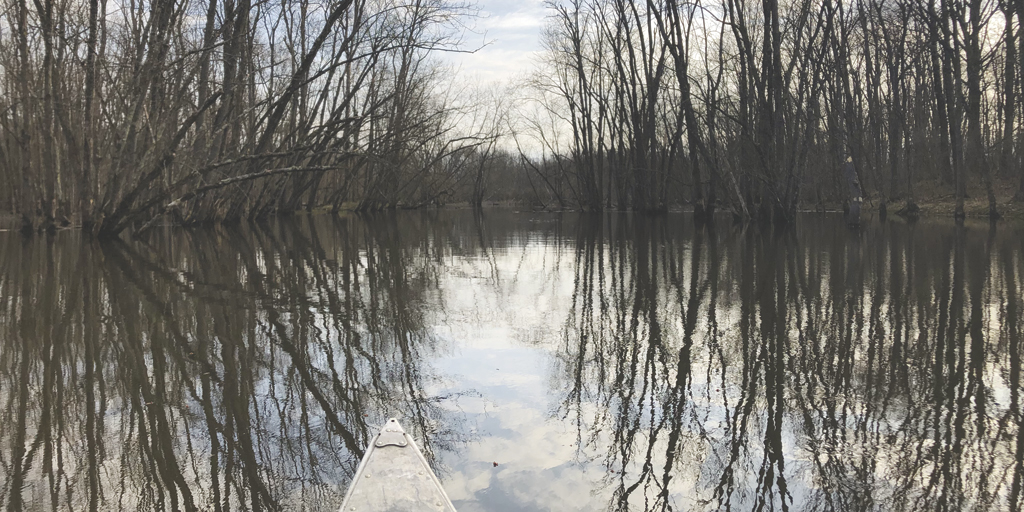
3. THE MAIDEN RIVER
The Cuyahoga River begins in what could charitably be called a swamp, more pond than river, in a remote section of Geauga County. The Cuyahoga’s course is U-shaped; if you draw a straight line between where we are at the headwaters on the right tip of the U to the left peak in Cleveland’s Flats, the line would only be 30 miles long. But if you follow the river, it is 84 miles from here to its mouth. At this spot, the still water encircles the trunks of the maples, beeches and pines, with no evident current, a world away from pollution and fires and freighters.
The trees, shooting out from the still surface at droopy angles, will begin blooming in a few weeks. Birds trill and woop-woop from still-bare branches. Our 17-foot aircraft-aluminum Grumman canoe, which naturalist Dan Best and I use to paddle around logs sticking out of the water, is the only evidence of humanity in sight. It’s only 8 in the morning, and I’ve gone stiff from the car ride out, but the paddling is relaxing.
A few minutes ago, Best and I had met down by the muddy shore at Eldon Russell Park in Troy Township. The bearded, bespectacled naturalist with the Geauga Park District unloaded the canoe from his red Toyota pickup truck and placed binoculars around his neck. We paused by the bank to talk through the morning’s journey — a mile upriver, to the Cuyahoga River’s official starting point — and watched a water snake slither to the bank, its snout rippling the water’s crystalline surface.
A ways upriver, we see a little merle of birds twitching on a felled trunk. Best guides the boat closer as I crane for a look. Two blackbirds with spits of red on their shoulders sense us and flap away. But the last one just hops to a distant log. Another little group greets it with steely shrieks. Best scans it with his binoculars and identifies it as a rusty blackbird. Their numbers have declined in recent years, by some estimates as much as 90 percent, but they have a home in swamps like this one. This bird must have migrated down for the season from the Canadian wetlands. “We enjoy having ’em,” Best says, picking up his paddle again. “Their sound sounds like squeaky metallic machinery.”
The fact that the clanging squawk of industrial machinery still sounds foreign here is largely due to one man: Wendell R. LaDue. In 1933, LaDue was made superintendent of the city of Akron’s water department. The river descends slowly in a series of switchbacks south from this swamp, and eventually into the city of Akron. The city had just started to pipe drinking water from the Cuyahoga then, as it still does today, and LaDue was intent to keep its source clean.
In the 1920s and ’30s, the department bought thousands of acres of rural property along the Cuyahoga. Some were left to grow wild, and some were flooded to make reservoirs. More were leased to farmers who used techniques that the department certified would not harm the water supply. LaDue’s aim was clear: conserve vast swaths of land around the Cuyahoga, and with them, the cleanliness of Akron’s water.
As we continue upriver, a sign of LaDue’s success, a bird, lands on a branch about 100 yards away. A flash of silver explodes from the river below. The freaked-out bird flutters away as a fish arcs through the air with a splash. “Probably a carp, breaching like a whale,” Best says.
Fish are just one part of the headwaters’ bounty. Otters, minks, muskrats and beavers all leave chewed-up branches along the banks, used to build dams and lodges. Best estimates that there are about 75 species of native birds here too, including the prothonotary warbler, a yellow pipsqueak of a songbird with a screeching cry like a sound system malfunction.
“Alright sir, we have arrived,” Best says, plopping his paddle in the water to slow the canoe down. “That is the confluence.”
READ MORE: I Walked Across Lake Erie — Alone
The official start of the Cuyahoga is a smaller than I expected. Up ahead, it splits like two paths out of a fantasy novel. Smaller rivers, the Cuyahoga’s east and west branches, flow in toward us from the left and right. A finger of land pokes out between them and tapers into a point, where spindly trees and scrubby bushes grow. The banks along the east branch cut straight lines through the swamp. I easily detect the intrusion of a human hand.
The spoil banks are the legacy of a meddler named Pace Latham, Best says. A hardheaded Troy Township resident, Latham served as a Union Army cannoneer. In 1901, Latham decided to make the upper Cuyahoga straighter and deeper. He wanted to drain the swampland, and use the rich soil to farm onions.
Latham dug out three miles of the East Branch, creating small, levee-like banks and a straight channel. Then he realized a natural rock dam downriver in Hiram would foil his plan. The swamps wouldn’t drain. Being well-acquainted with explosives, Latham sent hired men to blow up the problem.
They tried to set the charges, but locals toting shotguns chased them away. When they tried a second time, the locals showed up with their shotguns again. Latham was forced to abandon his plan.
If Latham had won what became known as the Onion Wars, this portion of the Cuyahoga might have been changed forever.
Best and I turn the canoe around, and head back downriver. The canoe’s sides tinkle, the river like gentle rain washing off a tin roof. It reminds me of a sound from my childhood in rural New Jersey. We used to play in a ravine, where a river would crash over big rocks in a roar. But some would escape the flow, tinkling into little pools. I used to watch tadpoles flitting around below the pools’ surfaces. I’ve neglected to nurture that natural part of my life recently, I say. Maybe I shouldn’t.
“You haven’t lost it. It’s there. I think we’re all born with that natural affinity for nature,” Best says. “Rachel Carson famously coined it: ‘the sense of wonder.’ ”
We paddle back to the car, wondering.
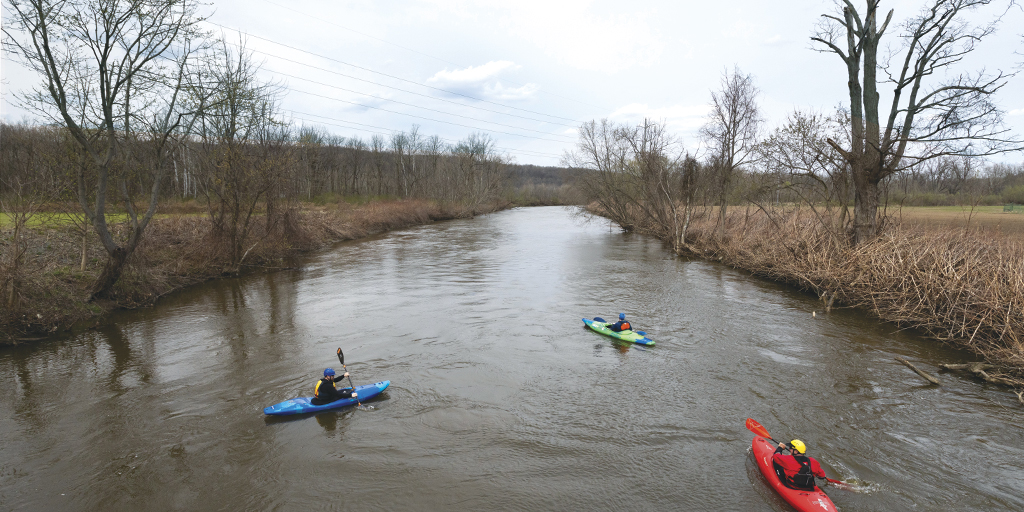
4. THE PEOPLE'S RIVER
On an afternoon in April, I meet McBride at Water Works Park in Cuyahoga Falls. People are walking their dogs and kids are clambering over, under and inside a nice playground. McBride waits beside a mini-bus with a trailer full of kayaks hitched to it, around which his three young boys play, shepherded by his wife, Moneen. Together they own Burning River Adventures, a kayak rental business.
Hundreds of thousands of people live, work and play beside this snaking section of the Cuyahoga as it winds through the cities of Kent, Munroe Falls, Cuyahoga Falls and Akron. It’s a mostly calm stretch, until downtown Cuyahoga Falls, where the river dips close to 200 feet, cutting through walls of shale and sandstone, and careening off huge rocks and boulders in a lethal set of rapids.
At the bottom of the ravine, the water meets a wall of bedrock and veers right by nearly 90 degrees. In less than a mile, the river turns from heading southwest, toward the Ohio River, to northwest toward Lake Erie. Flowing over the old Ohio Edison Dam, it falls farther still, into the depths of the Cuyahoga Valley.
After I clamber into the minibus, McBride drives to Brust Park, unloads two kayaks and heaves them down a grassy hill to the riverbank. The water is warm as I float my kayak, about 50 degrees, and smells fresh. In a calm eddy, I can see straight to the sun-dappled bottom. McBride pushes into the current: “Just paddle straight in and let it take you.” I do, and it shoves me gently downstream.
The McBrides started their company in 2015, McBride tells me as we paddle. He’d grown up boating and fishing. He started the company because he wanted to share those childhood adventures with people. He chose the “Burning River” name as a nod to the past and a statement about its bright future. “I wanted to be a part of what happened with this river,” he says.
There has been a boom in river recreation over the last few years, McBride says. Companies like Burning River Adventures have been thriving, from Camp Hi Canoe & Kayak, a 52-year-old canoe rental service in Hiram, to Float the River, a new tubing rental service that got its start this summer. But the marquee event is the Cuyahoga Falls Kayak Race, which, for the last four years has brought hundreds of spectators to watch dozens of pro-level kayakers crash over the only set of intense rapids in the Cuyahoga’s 84 miles.
Dam removals have been the current pushing this recreational boom along. One in Kent was modified in 2005 to allow boaters through. Two were removed in Cuyahoga Falls in 2013, and there are plans to take out the unused Ohio Edison Dam at the bottom of the Cuyahoga Falls gorge in the next five years. “Once that dam is removed, it’s going to connect that entire aesthetic, that entire recreational opportunity, that entire tourist attraction,” says Elaine Marsh, the co-founder of Friends of the Crooked River, which has advocated for dam removal.
There even used to be a dam in Brust Park, where our journey started. In the old days, it would have sent water crashing down on our heads. But today the river there is flat and pristine as it winds through residential neighborhoods. Paddling downriver, I can see people jogging along a trail.
“I took a Kent State anthropology student through here earlier today,” McBride says, as we round the bend back into Water Works Park, where Moneen left the minibus waiting. The student was working on a report about the river, McBride says, and was sure that the increase in recreational traffic would eventually harm its ecology. He shakes his head as he relays the story.
“I want to keep the river clean and the invasive species out as much as the next guy,” McBride says. “But the river is for people too.”
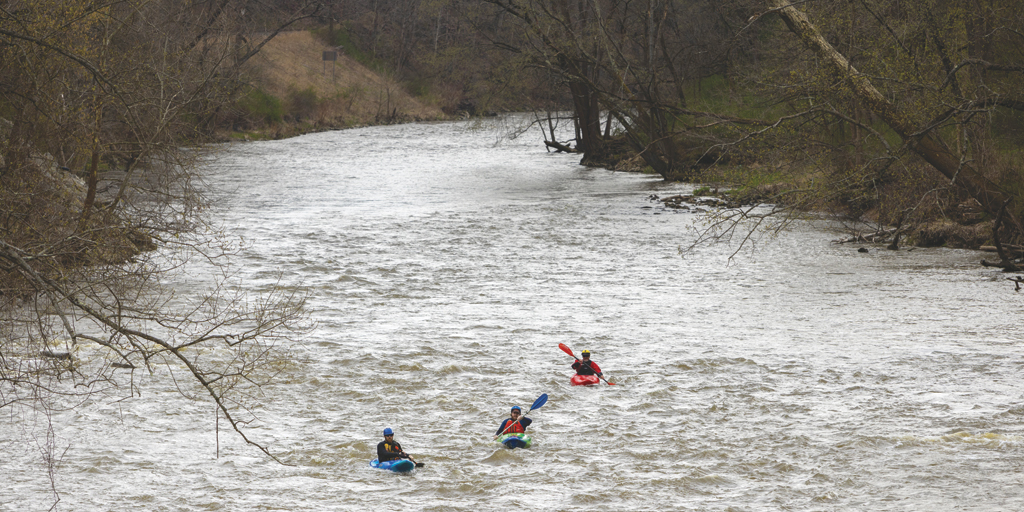
5. THE UNTAMED RIVER
I was, I had been told, being perhaps too chummy with danger. The plan was to kayak a 10-mile stretch of the Cuyahoga that runs through the Cuyahoga Valley National Park, just less than half of the park’s 22 miles of river. We would skim through some of its remotest sections, then sweep past Peninsula, going over the remnants of a low-head dam there (a not-at-all beginner-friendly splashdown of about a foot and a half) and brave a few tame rapids before trucking through Boston Mills. It seemed easy enough.
As I was going to bed the night before, though, I got a text from my traveling companion. Matt Fredmonsky is an experienced whitewater kayaker (and past freelancer for this magazine). I was trusting him to keep me alive. The current was running at a speed unsafe for someone of my experience level, he wrote. And the water was almost two feet higher than what Fredmonsky kayaks in summer. I could whip around one of the Cuyahoga’s many corners, get snagged on a downed tree dragging in the water (kayakers call them “strainers,” because you can get stuck against them like pasta in a colander), and drown under an unrelenting deluge of water. I slept like crap.
The next day, I scramble down the riverbank beside the Bolanz Road bridge to get a look at the current. It trucks past like a Norfolk Southern train behind schedule. Second thoughts hockey-stick through my mind so fast they threaten to explode out of my skull.
Luckily, Fredmonsky had the good sense to call for backup. It shows up in the person of John Zevenbergen, safety committee chairperson of the Keel Haulers Canoe Club and a recipient of swift-water rescue training. He goes over today’s safety guidelines: “Swim with your feet facing downriver,” and “If you get stuck on a strainer, try to climb over it, not swim under it,” and “Move your body, but keep your head steady.”
Like a chicken, I say.
“Right,” Zevenbergen says. “Like a chicken.”
I try not to think too hard on that metaphor as we stick our kayaks in the water and nose into the current. It feels like grabbing hold of a passing car. The bridge fades into the distance much too quickly. Fredmonsky and Zevenbergen are having such a grand time doing spins in their fancy whitewater kayaks that they miss a glimpse of a small brown animal, maybe a muskrat, that plops into the water. In my open-cockpit recreational kayak, borrowed from Burning River Adventures, I try to mirror their skillful turns, but fail miserably. Matt points out the problem: I’ve been holding the paddle upside-down. Amateur.
The first turn comes quickly, a brutal rightward 180-degree skid that doubles back almost straight south again. Fredmonsky and Zevenbergen show me how to paddle through it like a race car taking a tight corner, making sure the current doesn’t push me against the strainers jutting out of the opposite riverbank.
When the Mohawks named the river Cuyahoga, or “crooked,” they were underselling it. In the national park, the Cuyahoga dips, swerves, turns, backtracks and veers with plain animus for cardinal direction. If the river were perfectly straight, today’s route would be about six miles long. But the turns add four extra miles.
After a few turns, my fear of the current subsides. I begin to notice my surroundings.
Off to the right, in a swampy section, Fredmonsky points out a clump of what looks like at least 100 large bird nests dotted through the high reaches of a grove of trees. Inaccessible from the road, it is the most remote of three heronries in the national park, made by long-necked, needle-billed Great Blue Herons, which pair off there and raise their young.
As we approach Peninsula and pass under a Cuyahoga Valley Scenic Railroad trestle, a familiar jolt again cuts through my gut. A red-lettered sign high on a steep hillside warns boaters to get out before the low-head dam comes ahead. It doesn’t say where. The sun has gone beneath some clouds. The river goes choppy. The current shoves stronger at my back.
My breathing is ragged as we pass under the Streetsboro Road bridge in downtown Peninsula. The kayak bobs and slaps the water. I paddle harder to keep it steady. A chill sloshes onto my wetsuit. Matt’s advice repeats in my mind: “Momentum is safety.”
The old dam is ahead. The drop looks enveloped by roaring whitewater, bank to bank. I’d read people get pinned underneath low-head dams like what used to be there. They drown. And I am pointed straight at it.
Fredmonsky yells, “Dig, dig dig!”
I dig and dig and dig.
I don’t feel the fall. A wave of water smacks my chest, face and eyes.
All I can see is a blob of neon green, the kayak’s prow. It thunks through the spray.
I am level again, seeing, breathing and hollering.
“WHOOOOOO!”
I look around. Fredmonsky and Zevenbergen have, of course, made it too. It was a kiddie ride for them. The current is flowing strong here, though, as choppy as before. We cannot stop. We push and push as the river makes a sharp westward turn, then meanders north again. “Anyone want a break?” Fredmonsky finally calls, once it’s safe.
We pull the kayaks to land. About 20 feet away, joggers and walkers are taking afternoon jaunts on the Towpath Trail. I catch my breath and drain a whole water bottle, admiring the soaring shale cliffs on the opposite riverbank, which are layered and flaky like the innards of a giant earthen croissant.
A few minutes later, we are back on the water, cruising underneath the pylons of Interstate-80 and Interstate-271, past the Boston Mills/Brandywine Ski Resort and another series of bends, until we reach the site of this section of the river’s most significant past environmental challenges. One riverbank is covered in boulders, the site of the old Jaite Paper Mill’s dumping grounds. This section is erosion-prone. The pile of rocks on the bank is supposed to stave off future leaching of sediment downriver.
The current carries us past it and under an old, rusting railroad bridge, where we reach the site where a farmer once dumped about 150 car frames on the western bank. He was trying to keep the river from slowly eating his sod fields.
In 1991, the Friends of the Crooked River advocacy group and the National Park Service cleaned them up. It was part of the first-ever River Day, the goal of which was to attract more people to the Cuyahoga’s banks, Marsh tells me later. “We felt that at that time, there was not enough of appreciation or knowledge of the river,” she says. “We thought that was our main part of our mission, was to get people down to the river because a lot of people didn’t know how much it had improved since what their memory served them.”
The banks show no sign of the piled-up cars today. They are clean and sandy, topped with tufts of bushes and marred only by collections of driftwood that we navigate around in the final bend of our journey.
Fredmonsky and Zevenbergen tell each other war stories as they haul their kayaks up the steep bank, stories about people who have drowned after getting their lifejackets caught on strainers and amateurs they’ve had to haul out of the racing waters. I yank my kayak up the bank after them. I’m a little proud. “Hey,” I deadpan. “At least you didn’t have to rescue me today.”

6. THE BURNING RIVER, PART II
We sit in our kayaks in front of the ArcellorMittal blast furnace, marveling at the spectacle. A giant bucket extends down, over and over, gobbling up chunks of raw material, which it then dumps into a feeder, like a claw hand at an arcade. Off to one side, train car after train car of coke — super-refined coal — sits waiting. A huge bulldozer and an equally large dump truck totter past.
The industrial scenery continues for what seems to my poor muscles like miles. From the water, I can see why Clevelanders so easily forgot the Cuyahoga: a wall of pipes, gray buildings and railroad tracks stands between the river and us.
As we round Marathon Bend — named for the small facility that the Canton refiner keeps there, complete with a “Welcome to Cleveland!” billboard exclusively for boats — Ridge fiddles with his phone and calls out: “There’s a freighter!” Using an app called MarineTraffic, he has sighted a massive boat rounding the curve ahead. We hang on the bulkhead while all 634 feet and 10 inches of the immense Sam Laud passes. The bulkhead rumbles and pulses with the gush of its engines.
With more people like us on the river — kayakers, rowers and fun-time boaters — collisions are increasingly becoming a hazard. Commercial boaters and recreational ones have been eying each other with unease. In 2013, two freighters were moored on opposite sides of the river from each other, cutting off the route for a planned rowing race. An accident would heat that already-hot cauldron to boil. Not today, though. High in the cockpit, the pilot sticks his hand out the window and waves.
“See?” Ridge says, after the ship passes. “Commercial and recreational can get along.”
At Collision Bend, underneath the shadow of the Terminal Tower, we see what the Sam Laud left behind: chopped-up bits of gizzard shad. The fish, unaccustomed to the Cuyahoga’s warm temperatures, have gone belly-up. The Sam Laud’s engines turned their bodies to chum, spraying the water with parts and a fish market stink. I nearly flip my kayak over as I grab a fat torso out of the water. It has no eyes, and its tail has been walloped off, as if by a machete.
“The signal for water quality is not just chemistry, but fish,” Jane Goodman, executive director of Cuyahoga River Restoration tells me later. “It’s what lives there and how healthy the things that live there are. It’s fish and bugs, basically.”
There are still considerable ecosystem challenges in the Cuyahoga. Goodman points to road salt, which seeps unseen into the river’s 800 miles of watershed and, eventually, into the river itself. Both Akron and the Northeast Ohio Regional Sewer District are also in the midst of a decadeslong process to get rid of their combined sewer systems, which empty bacteria into the river, at a combined cost of roughly $4.4 billion. And, Friends of the Crooked River’s Marsh says, new development along the banks could have unforeseen consequences. “Environment is a dynamic thing,” Marsh tells me. “We can never assume we’re done with the river.” But eyes or no eyes, the presence of the stinky shad torso I toss overboard is a sign of a recovering ecosystem.
I am flagging as our group enters the final bend, passing The Foundry rowing and sailing academy, the sculptures of Hart Crane Memorial Park, the Merwin’s Wharf patio, the Cleveland Rowing Foundation and the cabin of Lorenzo Carter, Cleveland’s first permanent settler. After six miles of constant paddling, my shoulders ache. Each stroke is like heaving boulders through the water.
Finally, the river mouth is ahead. The sky has darkened, and the temperature has dropped — a sudden April storm. It is, I realize, very cold. I lose feeling in my hands. The kayak rocks back and forth dangerously as the swells get higher and higher. For the first time, I am very aware that below me are 23 feet of unforgiving water.
Up ahead, the railroad bridge at the mouth is down, and we race for it. Cold water soaks my pants and has managed to get inside my coat. It’s running down my back, and pooling in the kayak seat. I pull my hood up to guard against the spray.
A train rolls over us as we pass under the bridge. The plan was to round the Coast Guard station, to the beach at Wendy Park. But as we emerge on the other side of the bridge and eye the swells, some of which are about level with our heads, it seems wise to call that off. “Let’s get out over here!” McBride calls. I angle for where he points, a miniature bay beside the bridge. We climb out of the river in a sudden Lake Erie squall.
I started my Cuyahoga journey knowing of the fire and little else, and ended it having seen a river that is the healthiest it has been since the 1969 blaze, and maybe since industrialization began along its banks.
I saw a river we used, and abused, and are using again. Parts of it smelled bad. Parts of it could have killed me. Parts of it were exploding with life. But in the strange industrial way of things in Cleveland, and the quiet, dangerous way of those in nature, the Cuyahoga I saw was beautiful.
As I stagger up the bank from my kayak at the river’s end, my legs spasming from sitting in the same position for half a day, with no feeling in my hands and the lake winds freezing my soaked clothing, I feel oddly fond of the river that has done all this to me, like a little fire had been lit inside me, one that will not soon go out.
For more updates about Cleveland, sign up for our Cleveland Magazine Daily newsletter, delivered to your inbox six times a week.
Cleveland Magazine is also available in print, publishing 12 times a year with immersive features, helpful guides and beautiful photography and design.

